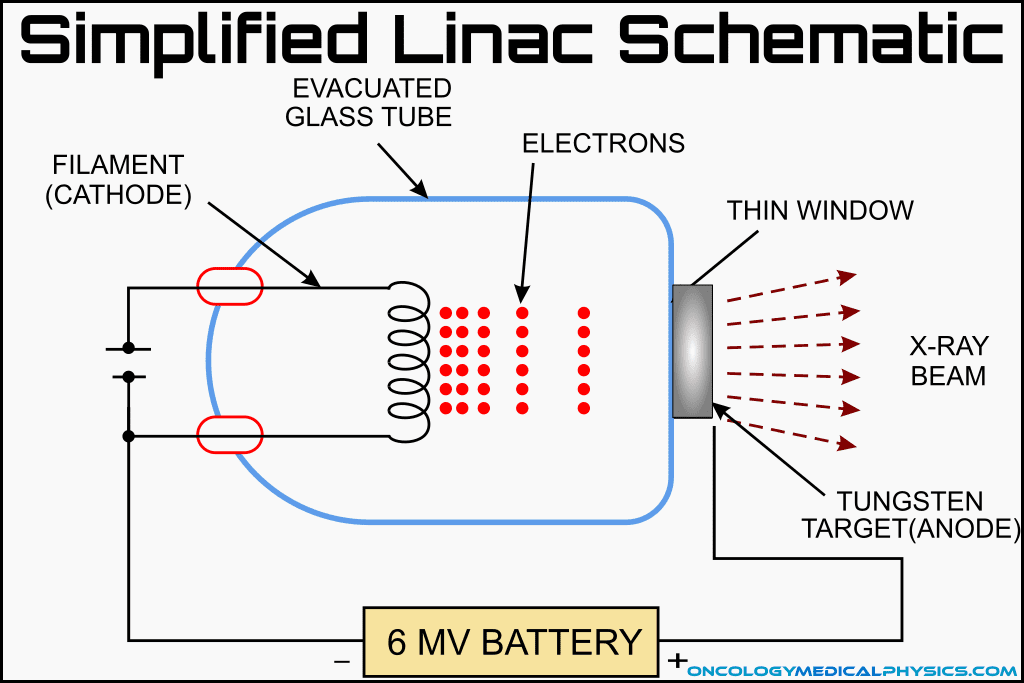Introduction to Clinical Linear Accelerators
The medical linear accelerator (linac) is the primary workhorse for radiation oncology. While the underlying principle of a linac is remarkably simple, implementation of that principle to produce a consistent stable beam requires a precise and sophisticated design. Understanding the basics of that design is essential to ensure patient safety and machine up-time.
In the basic accelerator design, a heated filament boils off a cloud of electrons. These electrons are then accelerated by an electric field applied between the filament (cathode) and a thin metal window (anode). Clinical linacs operating in the MeV region require an Accelerating Waveguide to achieve the required acceleration over a reasonable distance. The electrons then hit a target (where they produce Bremsstrahlung X-rays) or a scattering foil (to spatially distribute the electron beam). Finally, the beam may be further shaped in the treatment head.
Components of a Clinical Linear Accelerator
External Components
Couch (Patient Positioning System): The couch supports and positions the patient during treatment. Modern couches facilitate precise patient positioning by moving along the x, y, and z axis. Advanced couches may also include the ability to adjust patient roll, pitch, and yaw.
Electronic Portal Imaging Device (EPID): The electronic portal imaging device forms an image using the MV treatment beam. EPIDs are valuable tools for monitoring patient setup and quality assurance.
Gantry: The linac is mounted on a rotating gantry which treatment from multiple angles.
kV Imaging System: The kilovoltage imaging system consists of a kV X-ray generator and an electronic imaging device. The lower energy of this imaging system improves contrast, especially when used to generate a cone-beam CT.
Stand: The stand connects the gantry to the treatment room floor and contains electronics and other systems required for linac operation.
Internal Components
Accelerating Waveguide: A series of microwave resonance cavities used to accelerate the electron beam to high energies.
Bending Magnet: The bending magnet is a magnetic lens used to focus and position the beam to intercept the target (for photon treatments) or scattering foil (for electron treatments). The angle of bending varies by manufacturer but may be either 90°, 112.5°, or 270°. Magnetic focus attempts to be achromatic (does not separate by energy at point of focus).
Circulator: A device in the waveguide that is used to prevent microwave energy from reflecting backwards to the Klystron/Magnetron.
Cooling System: Production of a clinical treatment beam is an energy inefficient process due to losses in microwave generation and acceleration. A water or air cooling system is required to maintain a stable operation temperature necessary for consistent beam energy production.
Electron Gun: An electron gun produces the electrons which are accelerated in the accelerating waveguide. Electron guns consist of a heated filament (~800°C – 1100°C) which “boils off” a cloud of electrons. These electrons are immediately accelerated by a low E field (~40kV).2 Electron guns may be either of the diode or triode types. Diode electron guns consist simply of the heated cathode and an anode which set the accelerating voltage. Triode electron guns add a control grid between the cathode and anode which serves to recollect a portion of the liberated electrons. Thus, the triode design allows for variable beam current by preventing a variable fraction of electrons from reaching the accelerator.
Energy Selector: An energy selector may be placed within the bending magnet array to narrow the allowed electron energy range incident on the target/scattering foil. Typical energy band pass range in of the order of 6% (97%- 103% of desired energy).
Klystron/Magnetron: Klystrons and Magnetrons produce the microwave used to power the accelerating waveguide.
Treatment Head: The treatment head contains components required for beam production and shaping including targets, scattering foils, beam shaping collimators and the optical distance indicator.
Waveguide: The waveguide is a channel directing the microwave power from the Klystron/Magnetron to the Accelerating Waveguide. The waveguide is filled with an insulating gas (typically Sulfur Hexaflouride, SF6) to prevent electrical arcing. Microwave transparent ceramic barriers prevent the SF6 from leaking into the vacuum spaces filling the Klystron/Magnetron and the Accelerating Waveguide.
Navigation
Not a Member?
Sign up today to get access to hundreds of ABR style practice questions.




